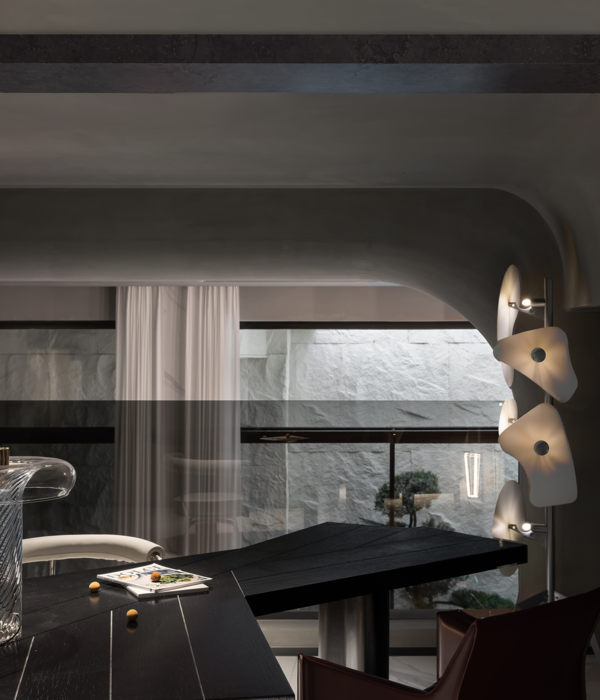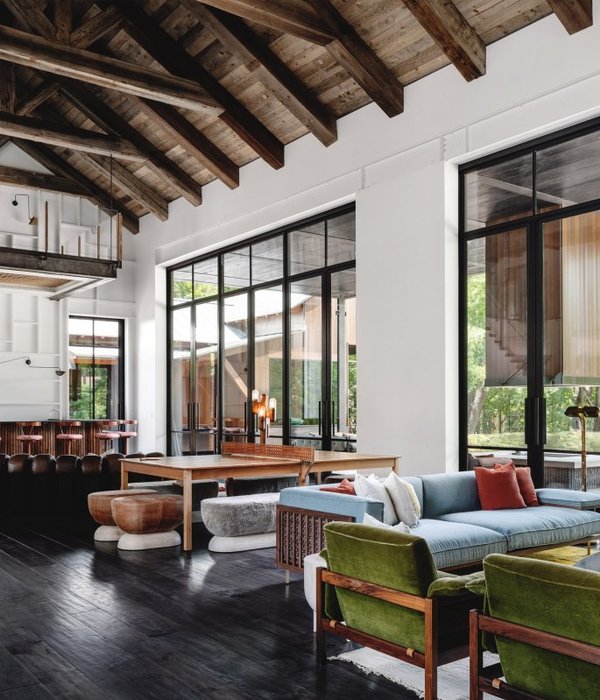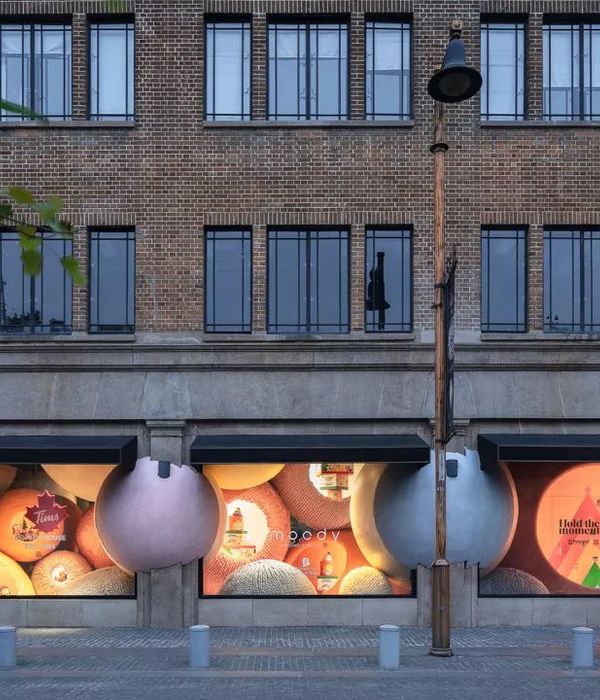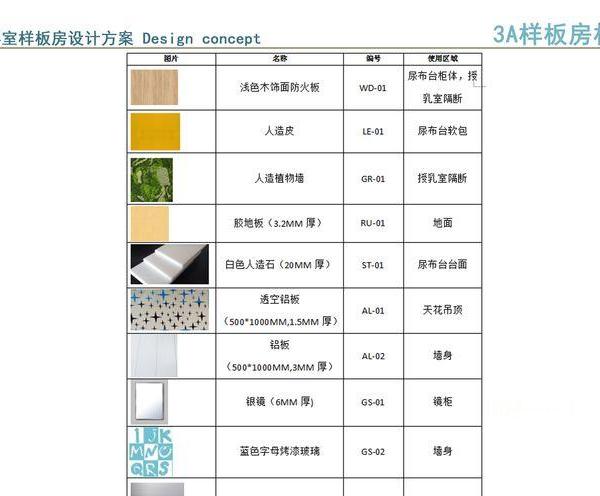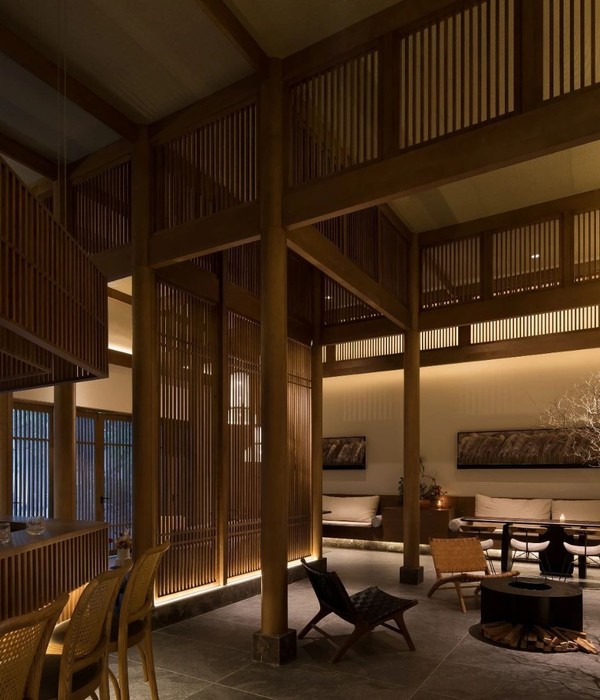Sectional Model. Image © Fondation Le Corbusier (FLC/ADAGP)
分段模型。图像(FLC/ADAGP)
第二次世界大战结束后,人们对勒柯布西耶在意大利的作品的需求并不短缺。在战后的几十年里,这个国家经历了令人难以置信的经济增长;这个最初主要是农业经济的国家迅速转变为一个主要的工业国家。[2]这位建筑师已经被委托为米兰以外的Olivetti公司设计一个新的总部,当时威尼斯城以他们自己的委托为他设计了一所新医院。这座新建筑将坐落在圣吉奥布附近,是一座照顾严重和绝症患者的设施。
There was no shortage of demand for Le Corbusier’s work in Italy after the end of the Second World War. The country experienced incredible economic growth in the decades following the war; what had previously been primarily an agricultural economy rapidly transformed into a major industrial nation.[2] The architect had already been commissioned to design a new headquarters for the Olivetti Company outside of Milan when the city of Venice approached him with their own commission for a new hospital. The new building, which would stand in the neighborhood of San Giobbe, was to serve as a facility for care of the seriously and terminally ill.[3]
There was no shortage of demand for Le Corbusier’s work in Italy after the end of the Second World War. The country experienced incredible economic growth in the decades following the war; what had previously been primarily an agricultural economy rapidly transformed into a major industrial nation.[2] The architect had already been commissioned to design a new headquarters for the Olivetti Company outside of Milan when the city of Venice approached him with their own commission for a new hospital. The new building, which would stand in the neighborhood of San Giobbe, was to serve as a facility for care of the seriously and terminally ill.[3]
勒柯布西耶的提议并没有从城市的其他地方作为一个厚颜无耻的现代主义标志站出来。相反,它利用了现有的城市词汇作为旧城市的无缝延续。该医院被构想为一个相互连接的模块的网络,这些模块围绕着许多方形庭院,这是威尼斯传统城市结构的一种清晰的模拟形式。与其他城市的建筑物一样,新的医院得到了许多打入威尼斯淤泥的桩的支持。然而,这些不是典型的木桩;参考他自己的设计佳能,LeCorbuiler选择在他的商标混凝土柱或Pilitis的网格顶上栖居医院。总的意图是,新医院将扩大城市结构,而不是中断城市结构。[4]
Le Corbusier’s proposal did not stand out from the rest of the city as a brazen Modernist landmark. Rather, it utilized the existing urban vocabulary to appear as a seamless continuation of the old city. The hospital was conceived as a network of interconnected modules clustered around a number of square courtyards, a clear analogue for Venice’s traditional urban fabric. As with the rest of the city’s buildings, the new hospital was supported by a number of piles driven into the Venetian silt. However, these were not typical wooden piles; in reference to his own design canon, Le Corbusier chose instead to perch the hospital atop a grid of his trademark concrete pillars, or pilotis. The overall intent was that the new hospital would extend the urban fabric rather than interrupt it.[4]
Le Corbusier’s proposal did not stand out from the rest of the city as a brazen Modernist landmark. Rather, it utilized the existing urban vocabulary to appear as a seamless continuation of the old city. The hospital was conceived as a network of interconnected modules clustered around a number of square courtyards, a clear analogue for Venice’s traditional urban fabric. As with the rest of the city’s buildings, the new hospital was supported by a number of piles driven into the Venetian silt. However, these were not typical wooden piles; in reference to his own design canon, Le Corbusier chose instead to perch the hospital atop a grid of his trademark concrete pillars, or pilotis. The overall intent was that the new hospital would extend the urban fabric rather than interrupt it.[4]
Long Section
长剖面
虽然勒柯布西耶选择模仿典型的威尼斯人结构类型,但他并没有为此牺牲功能主义。组成医院的单元几乎是相同的,包括面向三条走廊的28间病房;其中四个广场,被称为“护理单元”,被安排在一个中央小广场周围,这些广场的角落延伸成连接其他广场的走廊。该系统的设计是为了使医院能够在未来需要的情况下扩张,确保医院有足够的空间来增加病人负担和新发明的医疗设备。医院也是垂直分层的:行政和入境服务位于底层,病人卧室在顶层,所有其他医院项目需要在两者之间。
While Le Corbusier chose to emulate the typical Venetian structural typology, he did not sacrifice functionalism to do so. The modules that comprised the hospital were to be almost identical, featuring 28 patient rooms facing onto three corridors; four of these squares, dubbed "care units," were arranged around a small central square, the corners of which branched off into corridors connecting to other squares. The system was designed to allow the hospital to expand as needed in the future, ensuring it would have space both for added patient load and newly-invented medical equipment. The hospital was also vertically stratified programmatically: administrative and entry services were located at the ground level, patient bedrooms were on the top floor, and all other hospital program needs on the level between the two.[5]
While Le Corbusier chose to emulate the typical Venetian structural typology, he did not sacrifice functionalism to do so. The modules that comprised the hospital were to be almost identical, featuring 28 patient rooms facing onto three corridors; four of these squares, dubbed "care units," were arranged around a small central square, the corners of which branched off into corridors connecting to other squares. The system was designed to allow the hospital to expand as needed in the future, ensuring it would have space both for added patient load and newly-invented medical equipment. The hospital was also vertically stratified programmatically: administrative and entry services were located at the ground level, patient bedrooms were on the top floor, and all other hospital program needs on the level between the two.[5]
这个设计的一个奇怪的方面是在护理单位中缺少传统的窗户。唯一进入这一空间的日光是通过每间病房内走廊墙上的牧师窗进入的;一本美国杂志认为这是“不友善”,因为它剥夺了病人在住院期间凝视威尼斯泻湖的机会。
One curious aspect of the design was the lack of conventional windows in the care units. The only daylight to enter the space did so through clerestory windows along the inner corridor walls of each hospital room; an American journal considered this an “unkindness,” as it denied patients the opportunity to gaze out at the Venetian lagoon during their stay.[6]
One curious aspect of the design was the lack of conventional windows in the care units. The only daylight to enter the space did so through clerestory windows along the inner corridor walls of each hospital room; an American journal considered this an “unkindness,” as it denied patients the opportunity to gaze out at the Venetian lagoon during their stay.[6]
另一个引起关注的设计举措是从圣卢西亚火车站直达医院地面入口的汽车过道。虽然从大陆通往火车站的铁路桥旁已经修建了一条汽车堤,但勒柯布西耶的提议将使汽车进一步进入一个基本上没有车辆存在的城市-这是绝对无法选择的。该杂志质疑缺乏传统的窗户,认为汽车的规定是“不可原谅的”,甚至宣称这是阻止医院获得与周围历史建筑相同的建筑活力的一个特征。
Another design move which elicited concern was the automobile gangway leading from the Santa Lucia Railway Station directly to the hospital’s ground level entry. Though an automobile causeway had already been built alongside the rail bridge leading from the mainland to the station, Le Corbusier’s proposal would have brought cars even further into a city that remained largely devoid of their presence – firmly out of choice. The same journal which questioned the lack of conventional windows considered the provision for automobiles “inexcusable,” even declaring that it was the one feature that would prevent the hospital from achieving the same architectural vitality as the surrounding historical structures.[7]
Another design move which elicited concern was the automobile gangway leading from the Santa Lucia Railway Station directly to the hospital’s ground level entry. Though an automobile causeway had already been built alongside the rail bridge leading from the mainland to the station, Le Corbusier’s proposal would have brought cars even further into a city that remained largely devoid of their presence – firmly out of choice. The same journal which questioned the lack of conventional windows considered the provision for automobiles “inexcusable,” even declaring that it was the one feature that would prevent the hospital from achieving the same architectural vitality as the surrounding historical structures.[7]
考虑到勒柯布西耶对既有城市织物的典型蔑视,他对传统威尼斯美学的尊重似乎是反常的。在他的“Voisin计划”(Plan Voisin)简介中,他谴责了奥斯曼时代的巴黎建筑和林荫大道,认为它们是错位建筑和狭窄战壕的古怪组合-他坚称,这是一件令人厌恶的遗迹。[8]然而,当他辱骂巴黎时,他对威尼斯产生了一种奇特的爱好。早在20世纪30年代,他就把意大利城市称为理想的城市模式,赞扬其运河网络,并接受多种建筑形式和风格,而不需要虚假的、表面的连续性。虽然巴黎将代表他的现代主义者的愿望,擦净石板,重新建造,但正是在威尼斯,他会自相矛盾地拥护历史保护的好处。
Given Le Corbusier’s typical contempt for pre-existing urban fabrics, his deference to the traditional Venetian aesthetic seems anomalous. In the brief of his Plan Voisin, he decried the Haussmann-era buildings and boulevards of Paris as a grotesque mix of mismatched buildings and narrow trenches – a relic which, he insisted, was nothing short of disgusting.[8] While he reviled Paris, however, he developed a peculiar fondness for Venice. As early as the 1930’s, he referenced the Italian city as an ideal urban model, lauding its canal network and the acceptance of multiple architectural forms and styles without the need for false, superficial continuity. While Paris would represent his Modernist desire to wipe the slate clean and build anew, it was in Venice that he would contradictorily espouse the benefits of historic preservation.[9]
Given Le Corbusier’s typical contempt for pre-existing urban fabrics, his deference to the traditional Venetian aesthetic seems anomalous. In the brief of his Plan Voisin, he decried the Haussmann-era buildings and boulevards of Paris as a grotesque mix of mismatched buildings and narrow trenches – a relic which, he insisted, was nothing short of disgusting.[8] While he reviled Paris, however, he developed a peculiar fondness for Venice. As early as the 1930’s, he referenced the Italian city as an ideal urban model, lauding its canal network and the acceptance of multiple architectural forms and styles without the need for false, superficial continuity. While Paris would represent his Modernist desire to wipe the slate clean and build anew, it was in Venice that he would contradictorily espouse the benefits of historic preservation.[9]
Model. Image © Fondation Le Corbusier (FLC/ADAGP)
模特。勒柯布西耶基金会(FLC/ADAGP)
威尼斯医院的项目在勒·柯布西耶的生命中出现得很晚,他在1965年去世前几个月就提出了最终的设计方案。关于医院作为一种城市重建形式的价值的争论最终变得毫无意义,因为由于缺乏资金,城市最终选择了一种不同的设计,在大陆的一个地点。[10]然而,勒·柯布西耶的提议代表了他看似矛盾的观点的综合-一种功能性的、现代主义的历史主义。也许,勒柯布西耶的最后一个设计项目是为一个他深深敬佩的城市而设计的。
The Venice Hospital project came very late in Le Corbusier’s life; he proposed the final design only a few months before his passing in 1965. Debates over the value of the hospital as a form of urban renewal ultimately became moot as, due to a lack of funding, the city ultimately chose a different design for a site on the mainland.[10] Nonetheless, Le Corbusier’s proposal represents the synthesis of his seemingly contradictory viewpoints – a sort of functional, Modernist historicism. It was fitting, perhaps, that Le Corbusier’s final design project was for a city that he came to admire so deeply.
The Venice Hospital project came very late in Le Corbusier’s life; he proposed the final design only a few months before his passing in 1965. Debates over the value of the hospital as a form of urban renewal ultimately became moot as, due to a lack of funding, the city ultimately chose a different design for a site on the mainland.[10] Nonetheless, Le Corbusier’s proposal represents the synthesis of his seemingly contradictory viewpoints – a sort of functional, Modernist historicism. It was fitting, perhaps, that Le Corbusier’s final design project was for a city that he came to admire so deeply.
ArchDaily想确认SOCKsStudio是本文的主要素材来源。有关这个未构建的项目的更多信息可以在这里找到。
ArchDaily would like to acknowledge Socks Studio as a key source of material for this article. Further information related to this unbuilt project can be found here.
ArchDaily would like to acknowledge Socks Studio as a key source of material for this article. Further information related to this unbuilt project can be found here.
参考文献[1]LeCorbuiler."计划Voisin,巴黎,法国,1925年。"FoningLeCorbuiler。2016年5月18日访问。[2]S.Signreta,PaolaE."意大利-经济奇迹。"百科全书Britannica。2016年5月12日。[访问][3]Flint,Anthony.现代男人:明天的建筑师LeCorbuiler的生活。波士顿:HoughtonMifflinHarcourt,2014年。P184。[4]Verderber,斯蒂芬,和DavidJ.Fine。在激进变革时代的保健架构。纽黑文,CT:耶鲁大学出版社,2000。p24。[5]Fabrizi,Mariabruni."这座大楼是这座城市:LeCorbuiler的未建成的医院......"短袜工作室。2014年5月18日。[访问][6]Verderber,斯蒂芬,和Fine,p24。[7]费利齐。[8]LeCorbuiler,“计划Voisin。”[9]Corbusier,Le,Stantislausvon。Moos和ArthurRU是鸡蛋。LeCorbuiler之前的LeCorbuiler:应用的艺术,建筑,绘画,摄影,1907-1922。纽黑文:耶鲁大学出版社,2002。P153。[10]Verderber,斯蒂芬,和Fine,p24-25。
References [1] Le Corbusier. "Plan Voisin, Paris, France, 1925." Fondation Le Corbusier. Accessed May 18, 2016. [2] Signoretta, Paola E. "Italy - The Economic Miracle." Encyclopedia Britannica. May 12, 2016. [access] [3] Flint, Anthony. Modern Man: The Life of Le Corbusier, Architect of Tomorrow. Boston: Houghton Mifflin Harcourt, 2014. p184. [4] Verderber, Stephen, and David J. Fine. Healthcare Architecture in an Era of Radical Transformation. New Haven, CT: Yale University Press, 2000. p24. [5] Fabrizi, Mariabruni. "The Building Is the City: Le Corbusier’s Unbuilt Hospital In..." Socks Studio. May 18, 2014. [access] [6] Verderber, Stephen, and Fine, p24. [7] Fabrizi. [8] Le Corbusier, “Plan Voisin.” [9] Corbusier, Le, Stanislaus Von. Moos, and Arthur Rüegg. Le Corbusier before Le Corbusier: Applied Arts, Architecture, Painting, Photography, 1907-1922. New Haven: Yale University Press, 2002. p153. [10] Verderber, Stephen, and Fine, p24-25.
References [1] Le Corbusier. "Plan Voisin, Paris, France, 1925." Fondation Le Corbusier. Accessed May 18, 2016. [2] Signoretta, Paola E. "Italy - The Economic Miracle." Encyclopedia Britannica. May 12, 2016. [access] [3] Flint, Anthony. Modern Man: The Life of Le Corbusier, Architect of Tomorrow. Boston: Houghton Mifflin Harcourt, 2014. p184. [4] Verderber, Stephen, and David J. Fine. Healthcare Architecture in an Era of Radical Transformation. New Haven, CT: Yale University Press, 2000. p24. [5] Fabrizi, Mariabruni. "The Building Is the City: Le Corbusier’s Unbuilt Hospital In..." Socks Studio. May 18, 2014. [access] [6] Verderber, Stephen, and Fine, p24. [7] Fabrizi. [8] Le Corbusier, “Plan Voisin.” [9] Corbusier, Le, Stanislaus Von. Moos, and Arthur Rüegg. Le Corbusier before Le Corbusier: Applied Arts, Architecture, Painting, Photography, 1907-1922. New Haven: Yale University Press, 2002. p153. [10] Verderber, Stephen, and Fine, p24-25.
建筑师勒柯布西耶位置威尼斯,意大利建筑师负责勒柯布西耶客户Comune di Venzia项目,1965年照片勒柯布西耶基金会(FLC/ADAGP)类别医院
Architects Le Corbusier Location Venice, Italy Architect in Charge Le Corbusier Client Comune di Venezia Project Year 1965 Photographs Fondation Le Corbusier (FLC/ADAGP) Category Hospital
Architects Le Corbusier Location Venice, Italy Architect in Charge Le Corbusier Client Comune di Venezia Project Year 1965 Photographs Fondation Le Corbusier (FLC/ADAGP) Category Hospital
{{item.text_origin}}


